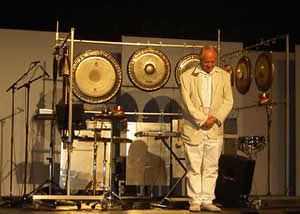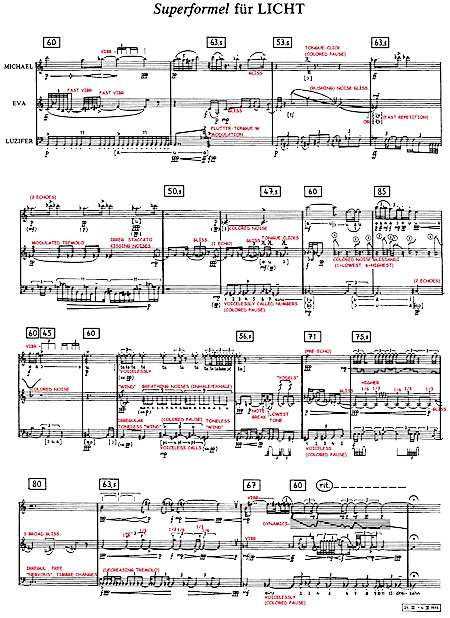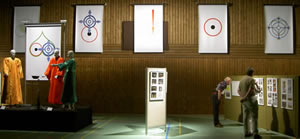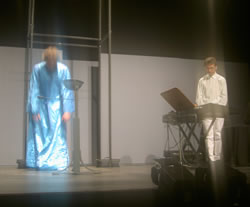On the morning of dec. 5th, 2007 due to a sudden heart
failure, Karlheinz Stockhausen passed away in his house in Kürten,
Germany. It was an unexpected message that caught me by surprise, on the
evening of friday dec. 7th ... I felt sad for the music, but most of all
for the passion, all the dedication, that has gone with
him. And no more summer courses in Kürten! At least not with
'the master'... I thought of Haus Hubertus, of professor doktor doktor B,
then of Vicky's Mosquitos,
and the road curling down from the hills to the village's high school and
the Sülztalhalle ... I turned over the leaves of the notebook that
I kept the summers that I went there. Looked at the quirky drawings that
I made, the words, the question- and exclamation marks. Oh, it was easy
to make fun of Stockhausen! Here is the final entry in my notebook, made
while assisting at his 2004 'Kompositions-Kurs' : " ... and this here
... now this is very interesting ... have a look at page 14, please! ...
this is where we flush the soprano down the toilet. This is completely new!
I have never done this before. For the first time in the history of music,
we flush a soprano down the toilet ... !"
 ... So here's
to you, mr. Stockhausen ... !
... So here's
to you, mr. Stockhausen ... !
allicht
august 19, 2004.
The German village of Kürten, out in the hills not far from Köln (Cologne), this year hosted, for the seventh time in succession, the yearly Stockhausen Courses. A tradition that started in 1998, the year of Stockhausen's 70th birthday.
My first serious encounter with Stockhausen's universe dates back to the early eighties, when Martijn Padding and I interviewed the composer on the occasion of the Stockhausen Project, a five-week-long stay (oct. 27 - dec. 1, 1982) of Kh. and his collaborators at the Royal Conservatory in The Hague. ("Twintig jaar voor Licht", Vinyl 22 [february 1983], p.28-31). Five unusually busy and singularly focused weeks for a Dutch music school, that saw itself confronted with a tightly composed schedule - day by day by day, or so it seemed, with many notes and little silence - that actually resembled a lot the ones in use for the courses in Kürten, with its evening concerts, its day time lectures and public rehearsals.
Early on in the the Hague Project I went to a public rehearsal of Luzifer's Traum for piano solo ("Lucifer's Dream" - Piano piece XIII for bass voice and piano is the first scene of Samstag ("Saturday")). If I remember rightly, it was not on a saturday, but early one sunday morning, which, with us barely awake driving down 'all the way' from Amsterdam, was a pretty unusual thing to do in itself in those days of night and rock 'n' roll :-) ... Kh. was sitting behind a table, listening and looking at a copy of the score. At regular intervals he interrupted the player, asked her to correct dynamics or tempi ("Nein, nein! Est ist pam-pam-pá-da-pam... 63.5! Bitte!") ... That player was his daughter Majella, who then was in her very early twenties. (Luzifer's Traum in fact had been sort of a present for her twentieth birthday.) She played the piano wearing white gloves with the fingers cut off (the score suggests to use for example coffin-bearers gloves), but she also whistled, rubbed and picked the strings, made sounds like p-i-ששש, uttered voiceless whispers, hit the piano frame with her hands, did a lot of counting in various tempi, in German, and in French with a sweet accent, stamped her foot, slapped her hands, fiddled two bundles of Indian bells hanging from brackets fastened onto the left and right edges of the piano frame, sat herself on the piano's keyboard to perform cluster glissandi with her thighs and buttocks, and she catapult-launched five home-made rockets... ("The rockets should fly from the piano through the air across the stage in various flight paths, landing - optionally with parachutes - at various locations on the stage.") ... all part of the composition (the piece lasts about 35 minutes), and all of it written, down to the smallest of detail, in the score.
I find it difficult to say whether I liked the piece, when I heard it for the first time that sunday morning. Over the years I have heard it again, several times. I saw it performed, by Majella, and later by Ellen Corver. I listened to it on CD, reading along in the score. And I still find it difficult to say whether I like it ... As many of the other scenes from Licht ("Light"), Luzifer's Traum is a musical ritual that simply refuses to fit into one of my little boxes of likes and dislikes.
Hearing it, and most of all: watching it being rehearsed, though, marked the beginning of an ongoing fascination with Stockhausen's work. Hardly (and fortunately) something that has been occupying me continuously. It is more of a 'being drawn to' that begets me periodically. And unfortunately the number of events that would have been worthwhile to attend (just to name one: the june 1995 premiere of the outrageous Helicopter String Quartet, the third scene from Mittwoch ("Wednesday"), in the Westergasfabriek in Amsterdam) largely outnumber the ones I did catch: most notably the Amsterdam performances of Samstag ("Saturday") (Concertgebouw, in 1984) and of Dienstag ("Tuesday") (Muziektheater, in 1992); and then, of course, the Courses in Kürten. [ Dutch readers may want to have a look at the short article that I wrote on the Stockhausen courses, back in 1999: "Licht (1)" (pdf) ]
 |
It had been five years since my last visit to Kürten. For all sorts of reasons ... As a matter of fact, I was reminded of this year's courses through an email I got from Michael Peters, who is living in Biesfeld, which is part of the community of Kürten. And as around the time of this year's events (from july 31th till august 8th) I happened to be in Maastricht with C. and the kids, and it's (modulo some serious jam-generating road works on the highway somewhere between Köln and Aachen) a mere hop from Maastricht to Köln, hence to Kürten, I decided to drive up to Kürten for a day or two. To once again sniff some of the atmosphere and attend a couple of the evening concerts. And to offline meet Michael, who was so kind to put C. and me up for the night ... (thanks, Michael, thanks Sabine!).
We arrived in Biesfeld in the early afternoon of august 3rd, and drove back to Maastricht after the evening concert of the next day, wednesday 4th. Which gave me the opportunity to attend (somewhat less than) one day and a half of this year's Stockhausen Courses. Not much, maybe not enough. But that's how it was ...
In this year's composition seminar Stockhausen 'analyzed' Hoch-Zeiten for orchestra, and Düfte-Zeichen (both from Sonntag). I attended tuesday's seminar, where he finished his 'analysis' of Hoch-Zeiten and the one on wednesday, where he started his description of Düfte-Zeichen.
The detailed structural descriptions Kh. gives in his composition seminars always follow the same general pattern. Maybe necessarily so, at least for the works that are part of Licht. (And of course, by now, most of his works are part of Licht (1977-2003)). For there is this one side to the work of Stockhausen, the rational and rigorous, the quasi-scientific side, about which it is easy to talk. Where it is easy to describe... For, well, there's the super formula for Licht, which, very generally, outlines the main properties of each of the seven 'days' (duration, main pitches ...)

Montag is determined by the super formula's first three measures, Dienstag by the next two, Mittwoch by measures 6 and 7, et cetera. A super formula for a 'day' then is obtained as, say, a 'zoom' on the corresponding measures in Licht's super formula. Which then in turn determines the general parameters for a certain number of 'scenes', each of which in turn will get a 'formal scheme' obtained as a 'zoom' on the corresponding measures in the 'day's super formula ... und so weiter.
 |
Methodologically, this is as simple and perspicuous as it as brilliant; because Licht's super formula will determine everything, and hardly anything at the same time. Now that is Licht's true stroke of genius, and I cannot but admire Kh. for this. Compare the composing of Licht to the construction of a large house with seven rooms. The super formula determines the general shape of the building, and, very importantly, its dimensions and confines, as well as the size and some of the characteristics of each of the seven rooms. Then, once one starts working within one of the rooms (the first 'zoom'), within the fixed size and characteristics there's still as much freedom as one wants to decide upon the room's furnishing and decoration; and once one then has come up with, say, the number and types of furniture, again there will be all the freedom to follow one's whims and impulses of the moment at the time of creating the actual pieces of furniture ... in fact, pretty much anything goes, and Licht is the living and breathing proof of this ... What is fascinating about the 'formula' method of working, the way it is applied by Stockhausen, is how it step by step narrows down the 'realm of choice'; from choices of a very general kind, down to choices for the smallest of details. Each successive 'zoom' creates its own, new, space of choices, waiting for the composer to make.
Stockhausen came up with this personal solution to the (eternal?) problem of artistic choice (what to do, what to use, and why?) by rigorously formalizing the process of choosing. It kept him working day and night for over 25 years ...
 |
As I said before: it is easy to talk about the structural side of these works. Their structural properties are readily expressed in numbers (tempi, pitches, et cetera), which are derived by more or less trivial procedures. These might seem complicated to a newbie, but let me assure you: they are not. There's nothing much deeper than some elementary arithmetic here. Once one understands the 'rules' and accepts whatever reason is given for their application, all - modulo the occasional exceptions - is straightforward. From that point of view Stockhausen's composition method almost seems 'scientific'. And if one hears him talking about his works, one might get the impression that all is but measure, number and arithmetic. But, watch out, for that is mere appearance. Stockhausen's is a weird science. His is a rationalized irrationality, if you like. When attending his composition seminars you will learn quite a bit about this rational side. That is what he'll go on and on about. It will however unveil but the slightest of hints as to the brazen-faced irrationality (and I mean this in the most positive sense) which, of course!, forms the beating heart of his art. You may learn some things about form, but hardly a thing about content. For this, you need to pay attention to his occasional side remarks, the afterthoughts, and the every now and then rant brought about by some question or other during the 'post seminar discussions'. They are the real reason why I continue to enjoy so much attending Herr Stockhausen's seminars and public rehearsals ... :-)
[ In september 2001, just before the WTC attacks, I spent a couple of days somewhere in the French Pyrenees writing a novella sized piece of English fiction, that turned out (I did not plan it, it just happened that way) to have the Kürten courses as its décor principal. It is called Mars & other Stars. A chapter appeared in the Canadian online literary journal Woodenfish (Mosquitos). As an addendum to the present SoundBlog-entry I made a downloadable pdf-file of five more pages from Mars & other Stars, which - in a fictionalized context, mind you - contain a more or less faithful transcription of part of a Kürten composition seminar :-> download seminar.pdf ]
So, then, what did I hear during my Kürten days?
On tuesday evening there was an 8 track projection of the Helicopter String Quartet; percussionist Michael Pattman performed Komet (a version of the scene Kinderkrieg from Freitag ("Friday")). And there was Pietà, from the second act of Dienstag.
This highly dramatic and touching piece for soprano, quartertone flugelhorn and electronic music, situated somewhere in the midst of Tuesday's masssive battle between Lucifer's troops (trombones and bass voice) and Michael's fighters (trumpets and tenor), is one of my favorite pieces from Licht, and definitely in my likes box. Written by Stockhausen in june 1990, it came about during a period of intensive experimenting together with his son Markus, who at the time had had a quarter-tone flugelhorn specially constructed. I knew Pietà only as played by Markus and the other 'original' performer, the soprano Annette Meriweather. So it was interesting to see and hear it performed here on this tuesday by others, even though still under the personal guidance of Stockhausen himself. (Markus for the last time was part of the Kürten Courses staff in 2001, and Annette Meriweather died in april 2002.) The quartertone flugelhorn was played by Marco Blaauw, the soprano was Barbara Hannigan. Of course their Pietà sounded different. That's pretty much unavoidable when human (solo) voices are involved, no matter how detailed the score, no matter how skilled the players, no matter how faithful their interpretation. Barbara has a voice that is much 'thinner' and less 'soulful' than the late Annette Meriweather's. And Marco's playing sounded 'coarser', lacking much of the 'lyricism' and 'natural magic' that's so evidently sparkling whenever 'Stockhausen plays Stockhausen'. Nevertheless, they did a great job. And they looked fantastic, btw ... Ahh ... music for the eyes ! ... :-)
 |
On wednesday evening we listened to a projection of the electronic and concrete music from Mittwochs-gruß; then, with a couple of flies and a night moth, attracted by the spotlights, circling around his head as if performing a dance that had been written out in the score, Benjamin Kobler interpreted Klavierstück VI; and finally we witnessed the premiere of the shortish Rosa Mystica, which corresponds to the 'Thursday scent' in Düfte-Zeichen, for tenor (Hubert Mayer) and synthesizer (Antonio Pérez Abellán). And for smoke ... as indeed, without Kh. actually venturing out into the wasteland of olfasonority, each day in Licht meanwhile does come with its own smell. In Düfte-Zeichen ("Scents-Signs", from Sonntag), these are, as incense fragrances, successively ignited by the seven day's singers.
Hence several times during the performance of Rosa Mystica, Hubert Mayer, dressed in Thursday's blue, threw a small handful of fresh incense into a metal bowl standing before him. "Lasset mich komponieren ewig Musik ...," he sang: "Let me eternally compose music ..."
Isn't that beautiful?
[ more web writing on Stockhausen and the courses: The Karlheinz Stockhausen web site | added October 13th, 2018): Stockhausen: Sounds in Space ]
Read about Karlheinz Stockhausen on the SoundBlog:
(2014, march 08) - "12 - 11 - 9 - 10 - 3 - 6 - 7 - 1 - 2 - 8 - 4 - 5"
(2013, october 12) - "At 19:07 the four helicopters flew over the Pont Neuf"
(2010, march 30) - on-g'luk = un-luck, that is: malheur, twice ...
(2008, february 12) - Karlheinz's Song of Praise
(2004, september 06) - vicky's mosquitos
(2004, august 19) - alLicht
comments for « alLicht » ::
|
Comments are disabled |